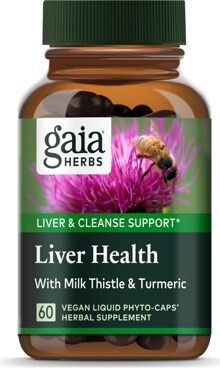
Gaia Herbs Liver Health
Go to Store| Serving Size: 1 Capsule | ||
| Servings Per Container: 60 | ||
| Amount Per Serving | % DV * | |
| Calories | 5 | |
| Milk Thistle seed extract + (Silybum marianum) (40 mg† Silymarins) | 57mg | † |
| Proprietary Extract Blend | 375mg | † |
| Turmeric root ▴ (Curcuma longa), Schisandra berry + (Schisandra chinensis), Chinese Skullcap root + (Scutellaria baicalensis), Licorice root ▴ | ||
|
* % Daily Value (DV) is based on a 2,000 calorie diet. Your daily values may be higher or lower based on your calorie needs.
† Daily Value (DV) not established. |
||
|
Other Ingredients: Vegetable glycerin, lecithin (non-GMO), water, and capsule (chlorophyll vegetable cellulose) |
||
|
Directions: Adults take 1 capsule 2 times daily between meals. |
||
|
Warnings: Not to be used during pregnancy or lactation. If you have a medical condition or take medications, please consult with your doctor before using this product. Keep away from children.Use only as directed on label. Safety-sealed for your protection. Keep bottle capped at all times and store in a cool, dry place. Natural separation may occur. This does not affect product quality. |
||
| Serving Size: 2 Capsules | ||
| Servings Per Container: 120 | ||
| Amount Per Serving | % DV * | |
| Calories | 5 | |
| Milk Thistle Seed Extract (Silybum marianum) | 57 | * |
| Proprietary Extract Blend | 375mg | * |
| Turmeric root, (curcuma longa), Schisandra berry (schisandra chinensis), Chinese Skullcap root (scutellaria baicalensis), Licorice root | ||
|
* % Daily Value (DV) is based on a 2,000 calorie diet. Your daily values may be higher or lower based on your calorie needs.
† Daily Value (DV) not established. |
||
|
Other Ingredients: Vegetable glycerin, sunflower lecithin, water and vegan capsule (hypromellose, chlorophyll |
||
|
Directions: Adults take 1 capsule 2 times daily between meals. |
||

Gaia Herbs Liver Health
Go to StoreFormula for Liver Support*
Liver Health is a powerful liver-support formula that helps fight free-radicals that are generated during stressful engagement with so-called toxins.* When a substance is metabolized in the liver, free-radicals are generated; this is a simple fact of nature. By direct antioxidant action, as well as supporting the function of the liver, this formula exerts a powerful influence.* The support of healthy tissue is also relevant for a number of herbs in this formula.*
Milk Thistle seed has a long history of traditional use; primarily as a support to liver health.* In modern times, we understand its ability to support liver tissue from the free-radical stress generated during liver metabolism.*
Simply stated, Milk Thistle seed has the following effects on the liver:
A. It is a powerful antioxidant
B. It promotes the liver's natural antioxidant system (that is the "mixed function oxidation system" including cytochrome P-450)*
C. It helps fight toxins, in part, by supporting cellular membrane stability*
D. It increases glutathione concentrations, supporting optimal liver function*
It is the combination of Milk Thistle's diverse actions that lend equal powerful support for the liver.*
It is interesting to note that the benefits of a number of 'spice cabinet' herbs used from ancient to modern times (such as Black Pepper, Ginger, Cayenne, Garlic, Turmeric, etc.) are being brought more fully to light by modern science. One of these kitchen herbs, Turmeric root, is traditionally recognized to support digestive and liver function.* A cousin of Ginger, Turmeric is a powerful antioxidant. It also demonstrates normalizing effects.* Like Milk Thistle, Turmeric aids liver function primarily by fighting free-radical oxidation generated during its metabolism.* Reducing this stress encourages normalized function of this metabolic organ.*
Schizandra berry is a valued kidney and male tonic.* Within this system it is often referred to as a 'king' or 'harmonizing' remedy, alluding to the broad-reaching influence of this small 'five flavored' berry. It is also deserving of great respect as an adaptogen (increasing non-specific resistance to stress).* In fact, the power of its adaptogenic influence has been compared to the highly regarded Siberian Ginseng. The depth of modern research compiled over the years on its use attests to Schizandra's validity. It has been suggested, specifically, to support function of the liver.* In China, compounds derived from Schizandra are being used for liver support with greater effect than the silymarins from the Milk Thistle.* In a similar manner as Milk Thistle, Schizandra may help support the liver's antioxidant systems while promoting the health of liver tissue.* Schizandra has also been suggested to increase liver cyclic AMP, which improves hormonal function at the cellular level.* This in turn results in an increase in overall function.* It simply cannot be overstated how valuable the Schizandra berry is to this formula.
Licorice root claims more than 3,000 years of use. Its early use to promote respiratory health is now being 'rediscovered' by modern scientific research. Licorice research suggests support for digestive health, among many reported effects.* Like Schizandra, it promotes cyclic AMP.* Perhaps most relevant to this formula, however, is the ability of Licorice to support healthy liver cells.* In addition, Licorice is able to promote the ability of the liver to handle toxins.* An entire book could be written on Licorice, for it is most definitely an extraordinary herb.
Chinese Skullcap has a long list of traditional applications to its credit, including use as a cleansing herb.* It is valued here as a powerful antioxidant. Similar to the other ingredients of this formula, Chinese Skullcap provides further support for the reduction of free-radical stress that is well-known to be generated at times of enhanced cleansing or challenges from external 'toxins'.*
Note: The intention of this information is to represent the traditional use of the individual botanicals found in these formulas and to inform the reader of any evolving scientific inquiry relevant to the formula's ingredients.
References
Pizzorno J, Murray M. Textbook of Natural medicine. New York. Churchill Livingstone; 1999.
Legalon. Madaus Education Monograph. Madaus. Germany. 1/2/10.94
Detoxification Profile. GSDL Education Monograph. Great Smokies Diagnostic Lab (GSDL). Asheville, NC. 1998.
Snow JM. Curcuma longa L. (Zingiberaceae). The Protocol Journal of Botanical Medicine. 1995; Autumn: 43-46.
Srimal RC. Turmeric: A brief review of medicinal properties. Fitoterapia; 1997;68(6):483-493.
Selvam R. The antioxidant activity of turmeric (Curcuma longa). Journal of Ethnopharmacology. 1995; 47:59-67.
Gengtao L. Hepato-pharmacology of Fructus Schizandrae. Advances in Chinese Medicinal Materials Research. 1985.
Ko KM, et al. Effect of a lignan-enriched Fructus Schizandrae extract on hepatic glutathione status in rats: Protection against carbon tetrachloride toxicity. Planta Medica. 1995; 61: 134-137.
Kent C. Licorice - More than just candy. Journal of the Australian Traditional Medicine Society. 1994; Autumn: 9-14.
Davis E, Morris DJ. Medicinal uses of Licorice through the millennia: The good and plenty of it. Molecular and Cellular Endocrinology. 1991; 78:1-6.
Snow JM. Glycyrhizza glabra L. (Leguminaceae). The Protocol Journal of Botanical Medicine. 1996; Winter: 9-14
Newmark TM, Schulick P. Beyond Aspirin. Prescott, Az. HOHM Press. 2000.
General References
Wren RC. Potter's New Cyclopaedia of Botanical drugs and preparations. Essex, UK. Saffron Walden;1988.
Bartram T. Encyclopedia of Herbal Medicine. Dorset. Grace Publishers; 1995.
Leung A, Foster S. Encyclopedia of Common Natural Ingredients. NY: Wiley;1996.
Bradley P (Ed.). British herbal Compendium. Dorset. British Herbal Medical Assoc.; 1992.
Mills S, Bone K. Principles and practice of Phytotherapy. New York. Churchill Livingstone; 2000.
Ellingwood F. American Materia Medica, Therapeutics and Pharmacognosy. Portland. Eclectic Medical Publications;1985.
Tang W, Eisenbrand G. Chinese Drugs of Plant Origin. New York. Springer-Verlag;1992.
Huang KC. The Pharmacology of Chinese Herbs. Ann Arbor. CRC Press;1993.
McGuffin M, et al. Ed. AHPA's Botanical Safety Handbook. Boca Raton: CRC Press, 1997.
Newall CA, et al. Herbal Medicines: A Guide for Health-Care Professionals. London: Pharmaceutical Press; 1996.
Weiss R. Herbal medicine. Beaconsfield, UK. Beaconsfield Publishers;1985.
Felter H, Lloyd JU. King's American Dispensatory. Portland. Eclectic medical Publications; 1983.
Duke J. Handbook of Medicinal Herbs. Boca Raton. CRC Press;1985.
Hoffman D. The Holistic Herbal. Moray. The Findhorn Press;1984.
Felter HW. The Eclectic materia Medica, Pharmacology and Therapeutics. Portland, Oregon. Eclectic Medical publications;1985.
Boon H, Smith M. The Botanical Pharmacy. Quebec, Canada. Quarry press;1999.
Mills S. The Essential Book of Herbal medicine. London. Penguin;1991.
Brinker, Francis ND. Herb Contraindications and Drug Interactions. Sandy, OR: Eclectic Medical Publications;1997.
Miller L. Herbal Medicinals: Selected Clinical Consideration Focusing on Known or Potential Drug-Herb Interactions. Arch Intern Med.1998;158: 2200-11.
Newall C, Phillipson JD. "Interactions of Herbs with Other Medicines." Online. Internet. [4/26/00].
Bensky D, Gamble A. Chinese Herbal Medicine: Materia Medica. Seattle: Eastland, 1986.
DeSmet PAGM. Adverse Effects of Herbal Drugs. Berlin: Springer-Verlag. 1993
Bergner P. "Herb-drug Interactions." Medical Herbalism. 1997. Online. Internet. [5/20/99]. Available WWW: http://medherb.com/92DRGHRB.HTM
WHO monographs on selected medicinal plants. Volume 1. Geneva: World Health Organization. 1999.





